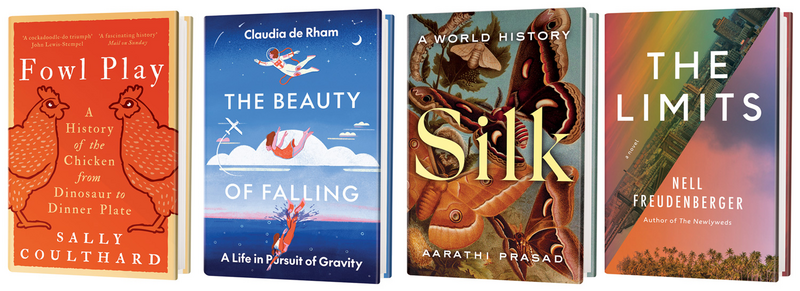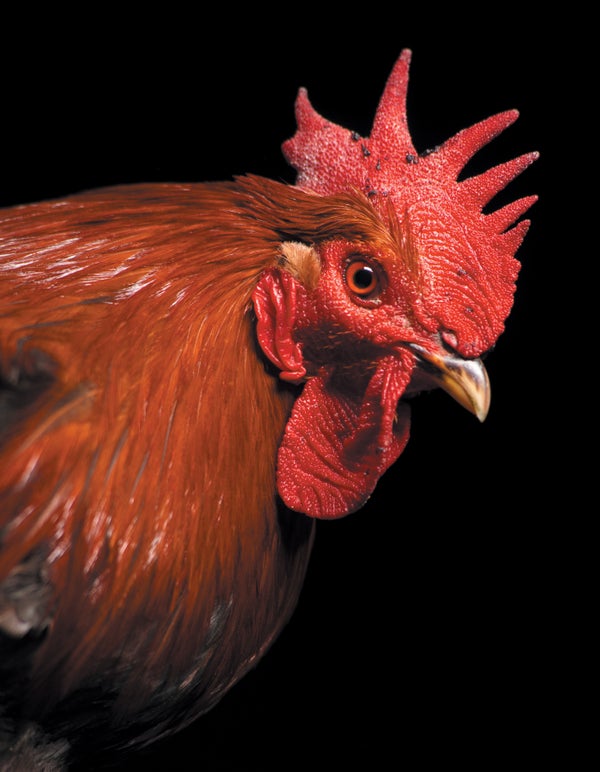How the Strange Relationship between Chickens and Humans Shaped Our World
How the Strange Relationship between Chickens and Humans Shaped Our World
Chicken takeovers, the missing histories of silk, a dazzling memoir of gravity, and more books out now
Serhii Yushkov/Getty Images
NONFICTION
Fowl Play: A History of Chicken from Dinosaur to Dinner Plate
by Sally Coulthard.
Apollo 2024 ($27.99)
As you’re reading this, there are more than 20 billion chickens alive on the planet. They live absolutely everywhere—except for Antarctica—playing important roles not just in our kitchens but in our cultures. In this extremely well-researched book, author Sally Coulthard traces the arc of the chicken from its ancestors among the dinosaurs through domestication by humans.
On supporting science journalism
If you’re enjoying this article, consider supporting our award-winning journalism by subscribing. By purchasing a subscription you are helping to ensure the future of impactful stories about the discoveries and ideas shaping our world today.
Refreshingly, Fowl Play doesn’t repeat false claims from past chicken histories. Instead it offers stories about the way chickens have shaped the human world, including the strange effects that domestication has had on chickens and humans alike. Chickens invaded our cultures and our language: “Brooding” men, hot “chicks” and “cocky” youths are all part of our vocabulary. Folk magic and religion rely heavily on chickens and their eggs as both physical objects and symbols. Eggs have been viewed as metaphors for rebirth and as a “harbinger of doom.” One particularly eye-opening section of the book traces the role of chickens in medicine. Not only were chicken eggs integral to vaccine development (they are still used for developing proteins and flu shots), but experiments on chickens (some quite bizarre) led to some of our earliest understanding of blood vessels and organ transplants.
For readers hoping to understand how the chicken got to be a species with such global dominance, Fowl Play is a welcome addition to the canon. Yet it’s focused on what people have done to—or taken from—chickens more so than the story of the birds themselves. “Of all animals,” Coulthard writes, chickens “perhaps best represent the strange and often contradictory way we humans treat other species.” Occasional mentions of scientific studies on chicken behavior simply present the information; she doesn’t go as far to suggest these findings imply that we should treat chickens as more than mere commodities.
Coulthard, who is a chicken keeper herself, does recognize the cost of our relationship with chickens from an ethical and environmental standpoint. One section explains why intensive chicken production is a major source of pollution and how widespread use of antibiotics for this production has been linked to the growing problem of antibiotic resistance. In Fowl Play, the contradiction in how we treat chickens isn’t just an abstract ethical conundrum; it is one with real consequences for our health and the health of the planet.
IN BRIEF
The Beauty of Falling: A Life in Pursuit of Gravity
by Claudia de Rham.
Princeton University Press, 2024 ($27.95)
“What exactly is gravity?” is the question that drives Claudia de Rham’s explorations of the puzzling, irresistible force that governs our universe. This part-memoir, part-textbook begins with a crash course in gravity’s fundamental nature, from Newton and Galileo to black holes and dark energy. Eventually de Rham introduces her and her colleagues’ groundbreaking theory of “massive gravity,” bringing readers to the cusp of a scientific shift beyond Einstein’s long-standing theory of general relativity. The best moments, though, are when de Rham recounts her own interfaces with gravity—as a scuba diver, pilot, aspiring astronaut and theoretical physicist—giving this force an alluring personality. —Lucy Tu
Silk: A World History
by Aarathi Prasad.
William Morrow, 2024 ($32.50)
A silk garment is not a single object but a composite of thousands of individual silkworm cocoons; likewise, there is no single history of silk. Biologist and writer Aarathi Prasad unwinds tangled threads to weave one arc through China, India, Europe and South America. We learn about dogged early scientists who crossed oceans and amassed massive personal collections to better understand silk’s biology and production. Fascinating facts abound: Bombyx mori is just one of a bevy of wild and domesticated silk-producing moths; “sea silk” can be isolated from a giant mollusk. Despite her efforts, Prasad readily asserts that many locals who shaped silk and its study “remain nameless”—their missing stories an unmendable hole. —Maddie Bender
The Limits: A Novel
by Nell Freudenberger.
Knopf, 2024 ($29)
When teenager Pia moves back to New York City to live with her father and pregnant stepmother, she struggles with friendships, family tensions and stifling COVID restrictions. She longs to return to the French Polynesian island of Mo’orea and to Raffi, an island native who assists with her mother’s research on deepwater coral. Pia’s infatuation with Raffi prompts her to join his struggle against the continued exploitation and degradation of the South Pacific, inspiring her to take ever bigger risks to show her devotion. Fiction writer Nell Freudenberger masterfully captures her characters’ divergent perspectives and complex ties as they encounter extreme circumstances. —Dana Dunham

How the Strange Relationship between Chickens and Humans Shaped Our World
Chicken takeovers, the missing histories of silk, a dazzling memoir of gravity, and more books out now

Serhii Yushkov/Getty Images
NONFICTION
Fowl Play: A History of Chicken from Dinosaur to Dinner Plate
by Sally Coulthard.
Apollo 2024 ($27.99)
As you’re reading this, there are more than 20 billion chickens alive on the planet. They live absolutely everywhere—except for Antarctica—playing important roles not just in our kitchens but in our cultures. In this extremely well-researched book, author Sally Coulthard traces the arc of the chicken from its ancestors among the dinosaurs through domestication by humans.
On supporting science journalism
If you’re enjoying this article, consider supporting our award-winning journalism by subscribing. By purchasing a subscription you are helping to ensure the future of impactful stories about the discoveries and ideas shaping our world today.
Refreshingly, Fowl Play doesn’t repeat false claims from past chicken histories. Instead it offers stories about the way chickens have shaped the human world, including the strange effects that domestication has had on chickens and humans alike. Chickens invaded our cultures and our language: “Brooding” men, hot “chicks” and “cocky” youths are all part of our vocabulary. Folk magic and religion rely heavily on chickens and their eggs as both physical objects and symbols. Eggs have been viewed as metaphors for rebirth and as a “harbinger of doom.” One particularly eye-opening section of the book traces the role of chickens in medicine. Not only were chicken eggs integral to vaccine development (they are still used for developing proteins and flu shots), but experiments on chickens (some quite bizarre) led to some of our earliest understanding of blood vessels and organ transplants.
For readers hoping to understand how the chicken got to be a species with such global dominance, Fowl Play is a welcome addition to the canon. Yet it’s focused on what people have done to—or taken from—chickens more so than the story of the birds themselves. “Of all animals,” Coulthard writes, chickens “perhaps best represent the strange and often contradictory way we humans treat other species.” Occasional mentions of scientific studies on chicken behavior simply present the information; she doesn’t go as far to suggest these findings imply that we should treat chickens as more than mere commodities.
Coulthard, who is a chicken keeper herself, does recognize the cost of our relationship with chickens from an ethical and environmental standpoint. One section explains why intensive chicken production is a major source of pollution and how widespread use of antibiotics for this production has been linked to the growing problem of antibiotic resistance. In Fowl Play, the contradiction in how we treat chickens isn’t just an abstract ethical conundrum; it is one with real consequences for our health and the health of the planet.
IN BRIEF
The Beauty of Falling: A Life in Pursuit of Gravity
by Claudia de Rham.
Princeton University Press, 2024 ($27.95)
“What exactly is gravity?” is the question that drives Claudia de Rham’s explorations of the puzzling, irresistible force that governs our universe. This part-memoir, part-textbook begins with a crash course in gravity’s fundamental nature, from Newton and Galileo to black holes and dark energy. Eventually de Rham introduces her and her colleagues’ groundbreaking theory of “massive gravity,” bringing readers to the cusp of a scientific shift beyond Einstein’s long-standing theory of general relativity. The best moments, though, are when de Rham recounts her own interfaces with gravity—as a scuba diver, pilot, aspiring astronaut and theoretical physicist—giving this force an alluring personality. —Lucy Tu
Silk: A World History
by Aarathi Prasad.
William Morrow, 2024 ($32.50)
A silk garment is not a single object but a composite of thousands of individual silkworm cocoons; likewise, there is no single history of silk. Biologist and writer Aarathi Prasad unwinds tangled threads to weave one arc through China, India, Europe and South America. We learn about dogged early scientists who crossed oceans and amassed massive personal collections to better understand silk’s biology and production. Fascinating facts abound: Bombyx mori is just one of a bevy of wild and domesticated silk-producing moths; “sea silk” can be isolated from a giant mollusk. Despite her efforts, Prasad readily asserts that many locals who shaped silk and its study “remain nameless”—their missing stories an unmendable hole. —Maddie Bender
The Limits: A Novel
by Nell Freudenberger.
Knopf, 2024 ($29)
When teenager Pia moves back to New York City to live with her father and pregnant stepmother, she struggles with friendships, family tensions and stifling COVID restrictions. She longs to return to the French Polynesian island of Mo’orea and to Raffi, an island native who assists with her mother’s research on deepwater coral. Pia’s infatuation with Raffi prompts her to join his struggle against the continued exploitation and degradation of the South Pacific, inspiring her to take ever bigger risks to show her devotion. Fiction writer Nell Freudenberger masterfully captures her characters’ divergent perspectives and complex ties as they encounter extreme circumstances. —Dana Dunham

